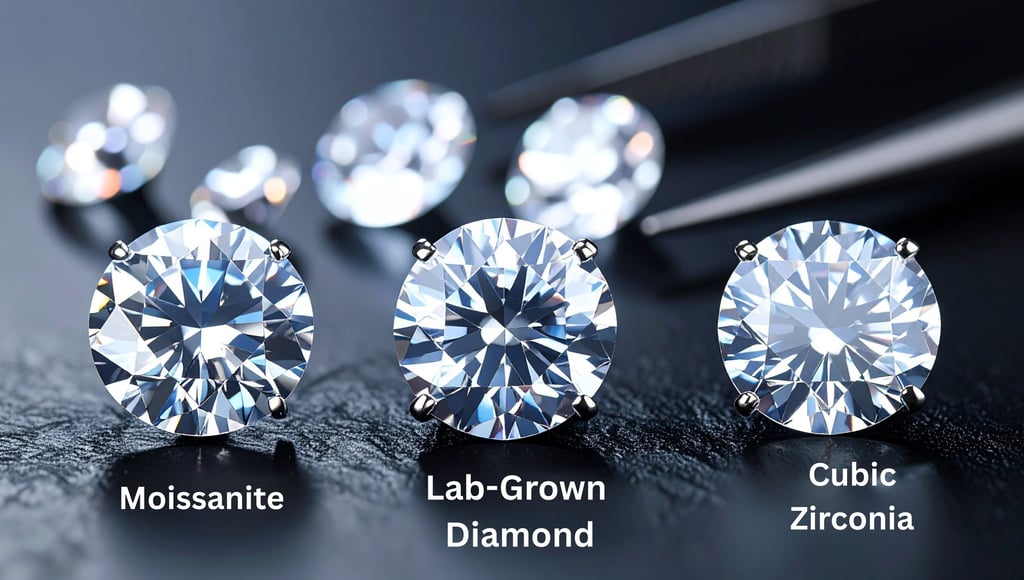Welcome to SHAMBH!
The Difference Between Moissanite, Cubic Zirconia, and Lab Diamonds
Diamonds and Simulants
SHAMBH
8/27/20254 min read


Shopping for jewelry can be a thrilling experience, especially when you're looking for that perfect, brilliant stone. But in today's market, you'll see a variety of terms: lab grown diamonds, moissanite, and cubic zirconia. While they may look similar at first glance, these stones are fundamentally different in their composition, properties, and value.
This guide is designed to cut through the confusion. We'll break down the key differences between these three popular choices, so you can confidently educate your customers and help them choose the stone that is perfect for them. As a brand that offers real natural diamonds and real lab grown diamonds, Shambh is your trusted partner for authenticity and quality.
The Fundamental Truth: A Diamond is a Diamond
This is the most important fact to understand: lab grown diamonds are 100% real diamonds. They are a true diamond, made of carbon atoms, just like a natural diamond. The only difference is their origin.
Moissanite and Cubic Zirconia (CZ), however, are not diamonds. They are known as "diamond simulants." This means they are completely different materials that are created to look like a diamond. The choice, therefore, is not just between different types of diamonds, but between a real diamond and a beautiful, diamond like alternative.
Lab Grown Diamonds: The Real Deal
Lab grown diamonds are a scientific marvel. They are created in a controlled lab setting using advanced technology that replicates the natural process of diamond formation. They have the same chemical, physical, and optical properties as natural diamonds. They have a perfect 10 on the Mohs scale of hardness, making them incredibly durable and ideal for a lifetime of daily wear.
Because they are real diamonds, lab grown diamonds are graded on the same 4Cs (Cut, Clarity, Color, and Carat) as their natural counterparts. They exhibit the same unique sparkle and brilliant white light that diamonds are famous for. A key value proposition is that they offer a real diamond at a more accessible price point, which is why they are so popular in modern jewelry today.
Moissanite: The Brilliant Alternative
Moissanite is a fascinating stone with a different origin story. It's a naturally occurring mineral composed of silicon carbide, first discovered in a meteorite. Today, almost all moissanite used in jewelry is created in a lab. While it looks a lot like a diamond, it's not.
Moissanite has an incredibly high refractive index (2.65 2.69), which is higher than a diamond's (2.42). This means it reflects more light, giving it an intense "fire" or colored sparkle. In larger stones, this can create a mesmerizing rainbow of flashes of color. It's also an incredibly hard stone, rating 9.25 on the Mohs scale, which makes it very durable. As an alternative, it's a fantastic and much more affordable stone.
Cubic Zirconia (CZ): The Affordable Simulant
Cubic Zirconia, or CZ, is the most common and widely recognized diamond simulant. It is a man made crystalline form of zirconium dioxide that has been used in jewelry since the 1970s.
Unlike lab grown diamonds and moissanite, CZ is a much softer stone, rating between 8 and 8.5 on the Mohs scale. This makes it more prone to scratches and chips over time. While it looks like a diamond when new, it can become cloudy and lose its sparkle with everyday wear. Because of its lower refractive index (2.22), it has a less intense sparkle than a real diamond. Its main appeal is its extreme affordability, making it a good option for fashion jewelry or temporary pieces.
The Side by Side Comparison: A Summary for Clarity
Here is a quick summary of the key differences to help you make an informed choice.
Lab Grown Diamond:
Composition: Pure Carbon, making it a real diamond.
Hardness: A perfect 10 on the Mohs scale, making it extremely durable for a lifetime of wear.
Sparkle: The classic brilliant white sparkle that diamonds are known for.
Value: A real diamond at a more accessible price point than a natural diamond.
Moissanite:
Composition: Silicon Carbide, a different material from a diamond.
Hardness: A very durable 9.25 on the Mohs scale.
Sparkle: A distinct, rainbow like sparkle with intense fire.
Value: A brilliant and durable alternative at a fraction of the price of a lab grown diamond.
Cubic Zirconia (CZ):
Composition: Zirconium Dioxide, a man made material.
Hardness: Softer at 8 to 8.5 on the Mohs scale.
Sparkle: Less intense than a diamond, and can appear cloudy over time.
Value: The most affordable option, best for fashion or temporary jewelry.
Shambh: Your Trusted Source for Authenticity and Quality
At Shambh, we believe in providing our partners with the highest quality, authentic stones, and the knowledge to back them up. We specialize in real diamonds, offering both the timeless heritage of natural diamonds and the modern brilliance of lab grown diamonds. We ensure every stone is certified and accurately represented, so you can confidently sell jewelry that your customers will cherish for a lifetime.
The choice between a lab grown diamond, moissanite, and cubic zirconia comes down to what you value most. A lab grown diamond offers the authenticity and durability of a real diamond at a great price. Moissanite provides a durable and brilliant alternative with a unique sparkle. And Cubic Zirconia is a beautiful, budget friendly choice for fashion pieces. The most important choice you can make is to understand the difference between a real diamond and a simulant.
Contact Shambh today to discuss your business needs and find the right stones for your inventory.
Elegance
Discover our exquisite diamond jewelry collections today.
Get in Touch
Subscribe
support@shambh.com
+91 96012 68918
© Shambh 2025. All rights reserved.
